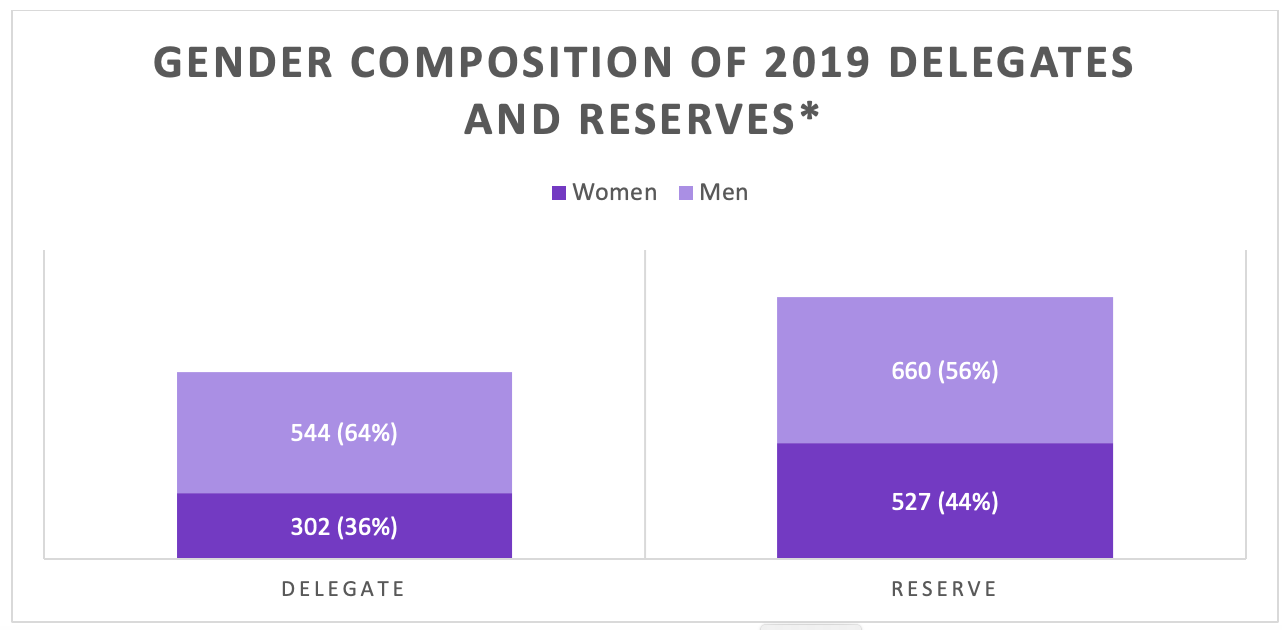By Magaela C. Bethune, MS, MPA
This report - the last of a three-part series by the General Commission on the Status and Role of Women (GCSRW) – continues a conversation on the gender breakdown of the 2019 Special Called Session of General Conference delegates.
Part One of the series revealed significant disparities in women’s representation among 2019 delegates, and Part Two showed how, over the span of a decade, these gender disparities have persisted. In this final installment, we explore how 2019 representatives are distributed by gender in either the delegate or reserve roles, revealing yet another layer to disparities in representation.
The General Conference is an international body of nearly 1,000 delegates, elected by annual conferences around the world that typically meets every four years[1]. The 2019 Special Called Session of General Conference was held in February 2019 to consider legislation regarding human sexuality. Ultimately, the Traditional Plan was passed with 438 – 384 votes, yielding existing statements about homosexuality, same-sex marriage, and the ordination of LGBTQ persons unchanged[2]. But amidst recent inquiries into voting irregularities regarding the eligibility and credentials of the voting delegates, the GCSRW explores the gender composition of these voting delegates, in comparison to those who serve as reserves.
2019 General Conference Delegates, Gender and Delegate Role
Annual conferences elect representatives up to a number determined by the ratio of representation in the General conference, called delegates. Additional delegates are elected to complete the number for the ratio of representation for jurisdictional or central conference, and these delegates – in order of their election – are reserve delegates to the General Conference[3]
. A total of 862 delegates were elected for the Special Called Session of General Conference, and of those who reported their gender (n=850), 36% were women and 64% were men[4] .
In the United States, additional delegates were elected by annual conferences as jurisdictional delegates who serve as reserve delegates to the 2019 General Conference. Of the reserve delegates who reported their gender (n=1,187), 44% were women and 56% were men. Women were significantly more likely than men to be elected to the reserve role rather than delegate role[5]. Of the 829 women elected, only 37% were elected as delegates, in comparison to 45% of the men elected as delegates.


*Gender was not reported for 12 delegates and 6 reserves.
Takeaways and Call to Action
While women make up 58% of UMC membership, they are underrepresented in the key delegate role within the General Conference (36% women delegates.) When elected, women are much less likely than men to be elected as delegates and are more likely to be chosen for reserves, even though neither groups are close to 50% women. Why do we elect more men than women as delegates (or reserves) when there are usually more women as annual conference members? What skills or traits do we associate as leaders with men that we may not be associating with women?
Women are less likely to be where key decisions and policies are made within The United Methodist Church, and this is a trend that has persisted over time. Women’s participation and equitable representation is essential to the health and strength of The United Methodist Church. Many studies show that having both men and women together at the table make better decisions than having tables that are not balanced[6]
In the upcoming annual conference session where delegates and reserves will be elected to the 2020 General Conference, the General Commission on the Status and Role of Women urges The UMC body to vote with intention to increase the number of women delegates and reserves to General Conference as a reflection of the membership in your annual conference.
[1] www.umc.org/who-we-are/general-conference
[2] http://www.umc.org/who-we-are/what-happened-and-what-didnt-at-general-conference-2019
[3] See article 3; http://www.umc.org/what-we-believe/section-vi-annual-conferences
[4] https://gcsrw.org/MonitoringHistory/WomenByTheNumbers/tabid/891/post/2019-special-called-session-of-general-conference-who-are-the-delegates/Default.aspx
[5] Results from a chi-square test indicated that General Conference delegates who were women differed from men by delegate role (e.g., delegates vs. reserves), X2(1, 2,037) 14.5, p<.001.
[6] http://gap.hks.harvard.edu/impact-gender-diversity-performance-business-teams-evidence-field-experiment.
